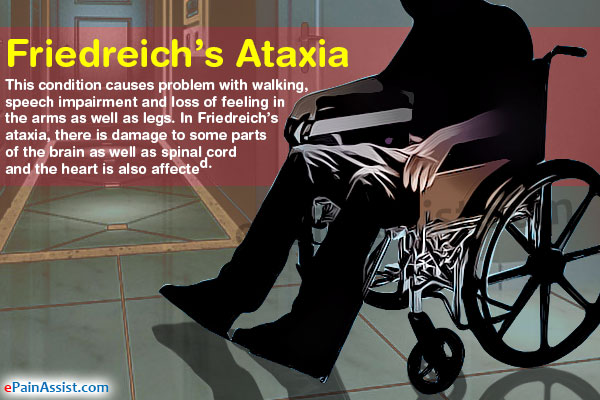Friedreich’s ataxia, also known as spinocerebellar degeneration, is a very rare disease which is of genetic nature. The word “Ataxia” is derived from Greek and means “lack of order.” There are different types of ataxia with different causes and Friedreich’s ataxia is one of them. This condition causes problem with walking, speech impairment and loss of feeling in the arms as well as legs. In Friedreich’s ataxia, there is damage to some parts of the brain as well as spinal cord and the heart is also affected.There is no cure for Friedreich’s ataxia; however, there are many treatments available, which help in managing the symptoms.
Causes of Friedreich’s Ataxia
Friedreich’s ataxia is a defect of genetic nature which is hereditary. A gene named frataxin is associated with this disease. In normal situation, this gene is responsible for producing up to 30 copies of a particular DNA sequence. When the production of this sequence of DNA gets out of control, then it results in severe damage to the brain’s cerebellum and the spinal cord.
Individuals having a family history of Friedreich’s ataxia are at an increased risk of inheriting this condition. In cases where the defective gene is inherited from only one parent, then that person becomes a carrier of this disease and commonly does not experience any symptoms.
Signs & Symptoms of Friedreich’s Ataxia
Patients can experience the symptoms of Friedreich’s ataxia as early as 18 months of age and as late as up to 30 years of age. Symptoms usually start between the age of 5 and 15 years. This condition, if it develops in patients when they are 25 years of age, is known as late-onset Friedreich’s ataxia. Very late-onset Friedreich’s ataxia can start after the age of 40. The first symptom of Friedreich’s Ataxia is difficulty in walking. The other symptoms experienced by patients are:
- Hearing loss.
- Changes in the vision.
- Muscle weakness.
- Absence of reflexes in the legs.
- Lack of coordination.
- Involuntary movements of the eye.
- Problems with speech.
- Problem with feeling any vibrations in the legs and feet.
- Development of foot deformities, such as clubfoot.
- Sometimes, patients with Friedreich’s ataxia can also develop some type of heart disease, such as hypertrophic cardiomyopathy. Symptoms of heart condition include: chest pain, palpitations and shortness of breath.
- In later stages, Friedreich’s ataxia can also lead to diabetes.
Investigations for Friedreich’s Ataxia
- Physical exam and medical history.
- Neurological exams to check for lack of reflexes, poor balance, lack of sensation in the joints.
- CT scan and MRI scan of the brain and spinal cord are done to assess the body’s inner structures.
- X-rays of the head, chest and spine are also taken.
- Genetic testing helps in finding out if the patient has the defective gene, frataxin, which causes Friedreich’s ataxia.
- Electromyography is done to measure electrical activity in the muscle cells.
- Nerve conduction study is done to see the speed at which the nerves send the impulses.
- An eye exam is done to check for signs of damage in the optic nerve.
- Additionally, echocardiograms and electrocardiograms are done to monitor or diagnose heart disease.
Treatment for Friedreich’s Ataxia
- There is no cure for Friedreich’s ataxia. Treatment is done to treat and manage the underlying conditions and patient’s symptoms.
- Speech therapy and physical therapy help in functioning of the patient and helps with the patient’s quality of life.
- Walking aids help the Friedreich’s ataxia patient in moving around.
- Orthopedic devices, such as braces, also help the patient suffering from Friedreich’s ataxia in moving around.
- Medications for Friedreich’s ataxia are given for other associated medical conditions, such as diabetes and heart disease.
- Surgery may be needed if the patient develops a spinal curvature or problems with his/her feet.
Prognosis for Friedreich’s Ataxia
There is worsening of Friedreich’s ataxia as the time goes on. Around 15 to 20 years, after the development of symptoms, most of the patients having Friedreich’s ataxia usually become wheelchair dependent. Patients with advanced ataxia may not be able to move around at all. The leading cause of death in patients with Friedreich’s ataxia is heart disease. It becomes life threatening by early adulthood. Patients having mild symptoms of ataxia tend to live a longer life. Around 10% of patients with Friedreich’s ataxia develop diabetes. Other complications of this condition include scoliosis, heart failure and difficulty in digesting carbohydrates.
Prevention of Friedreich’s Ataxia
As this condition is inherited, it cannot be prevented. If the patient plans on having children, then it is recommended to go for genetic counseling and screening. A counselor can give an estimate of the child’s chances of having Friedreich’s Ataxia with or without symptoms.
- National Institute of Neurological Disorders and Stroke: “Friedreich’s Ataxia Information Page”: https://www.ninds.nih.gov/Disorders/All-Disorders/Friedreichs-Ataxia-Information-Page
- Muscular Dystrophy Association: “Friedreich’s Ataxia”: https://www.mda.org/disease/friedreichs-ataxia
- Genetics Home Reference: “Friedreich Ataxia”: https://ghr.nlm.nih.gov/condition/friedreich-ataxia
- MedlinePlus: “Friedreich’s Ataxia”: https://medlineplus.gov/genetics/condition/friedreich-ataxia/
Also Read:

